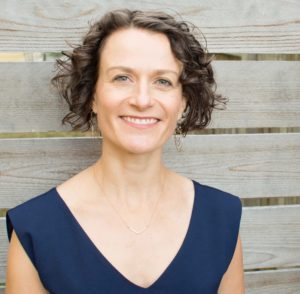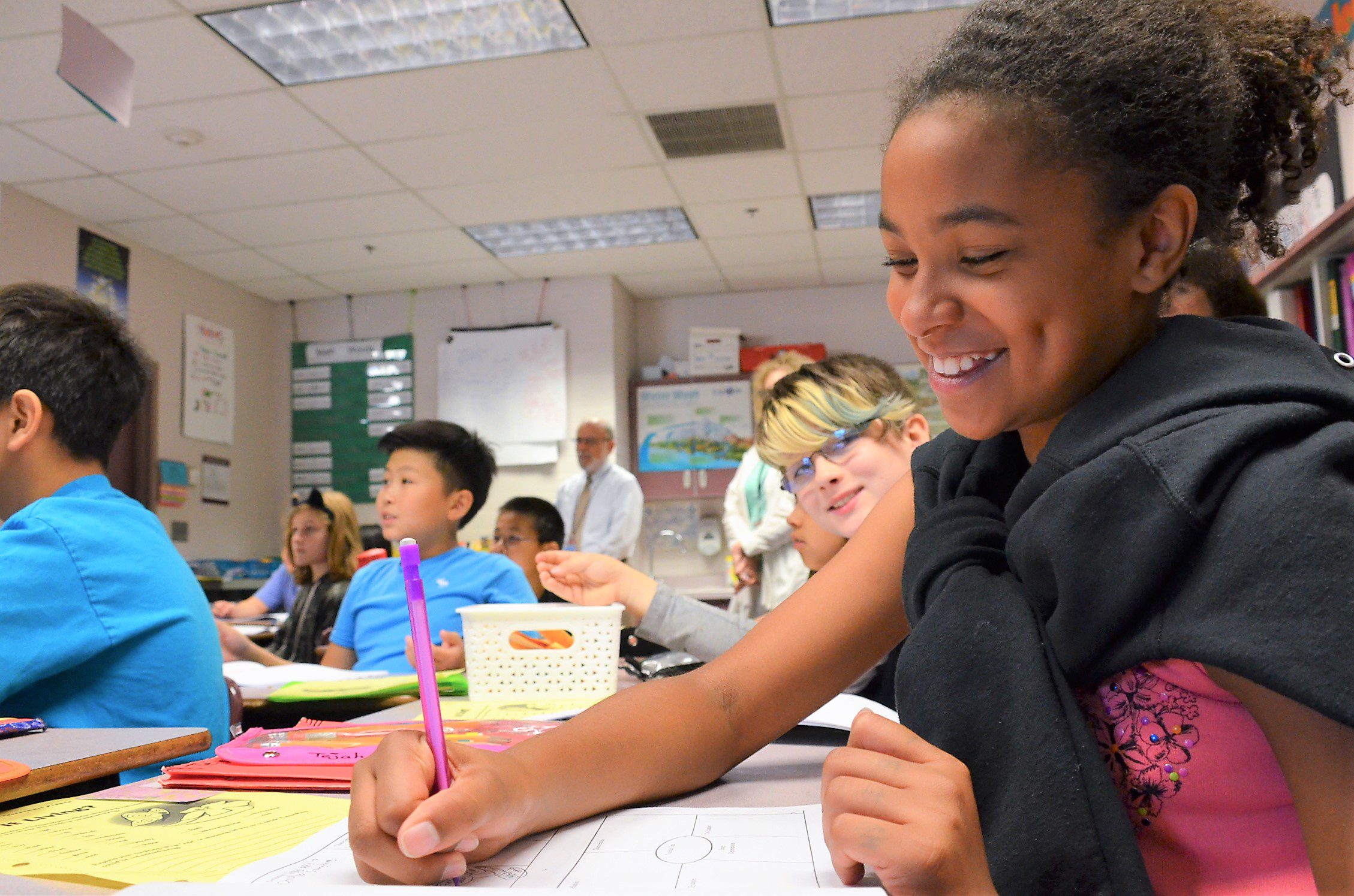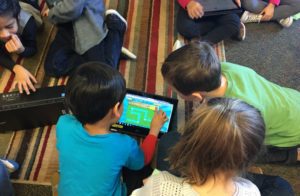
In this inaugural interview of The Throughline, Max Silverman speaks with Ellen Dorr (@ellenjdorr) about her strong commitment to educational equity and system design.
 Ellen Dorr serves as the chief technology officer for the Renton School District in Washington, where she oversees technology services including customer service, infrastructure and digital learning. She leads the team to provide the resources and supports to empower educators to create inclusive, equitable instruction in classrooms as well as increase efficiency and effectiveness across the district.
Ellen Dorr serves as the chief technology officer for the Renton School District in Washington, where she oversees technology services including customer service, infrastructure and digital learning. She leads the team to provide the resources and supports to empower educators to create inclusive, equitable instruction in classrooms as well as increase efficiency and effectiveness across the district.
Max Silverman: Ellen, as you know, here at CEL (the University of Washington Center for Educational Leadership) we focus on how adults in schools – and the central office where you work – create learning environments for students that are inclusive, engaging and ultimately lead to student ownership of their learning. Describe for our readers what you would love to see when you walk into a classroom or learning environment that has these characteristics.
“When things are easy for students and teachers, maybe it can feel better, but it’s not where we actually do real learning.”
Ellen Dorr: So I think some of it is more through feel rather than what you can see. In a classroom that has a learning environment that really honors and celebrates every student, you feel that kind of energy, and you feel connections among students and between students and teachers. There’s also this real sense of purpose. Students have a reason to be engaged. There’s something meaningful for them, there’s challenge for them.

Those same things apply to the adults in the classroom or in those learning environments. They also feel that same sort of drive to learn, to contribute, and to create.
When things are easy for students and teachers, maybe it can feel better, but it’s not where we actually do real learning. Real learning has challenge to it and it should also feel joyful in the end. Struggle is not easy all the time, but when we get to that place of recognizing, “Oh my gosh, I did that,” or, “I mastered that,” there’s a real sense of reward and it doesn’t come without that challenge.
Max Silverman: Based on your experience as a classroom teacher, coach and now in the central office, what challenges do you see in the world of teaching that we need to pay attention to in order to get better?
Ellen Dorr: There are two big things that need to be in place for teaching to be the learning experience that we want for students. One is a bigger vision. While some of what happens in classrooms is around specific standards, and specific skills, etc., we also have to always stay connected to that bigger why. What is the real vision? What are we really trying to create for kids? Getting to those learning targets is one thing, but how do you get there? The bigger vision is that we want students to have agency, we want people to feel empowered, and we want everyone to see value in what they’re doing. The vision piece has to always be there. Sometimes people get a little overly focused on content. Step back a little bit. What are you really trying to get at by having a student master chemistry? It isn’t just to know chemistry, it’s bigger than that. Taking a little step back feels hard when we have the urgency of what happens in school. But taking that step back to ask, what are we really trying to do for kids, shows that it’s not to make them more compliant and to fit in a box, it’s actually to have them be bigger than that.

The second thing, in addition to the bigger vision, is freedom and flexibility. As long as you’re always connecting to that bigger why, you should have the autonomy to do something different, to re-envision something because it gets you to that ultimate goal. Freedom and flexibility need to apply for students and teachers. When a teacher is saying students have to master this content, the freedom can be around how they demonstrate that. It doesn’t have to look the same all the time. When we give people autonomy, most times they astound us with what they’re able to actually put together.
Max Silverman: One of our foundational ideas is the notion of reciprocal accountability, where if I’m going to hold you accountable to perform better in different ways for your students, then I’m reciprocally accountable to support you in doing it. Could you share your view of what it looks like when a school leader is supporting the learning and growth of teachers?
“Co-learning should be happening everywhere.”
Ellen Dorr: For me the biggest idea here is that co-learning should be happening everywhere. When a school leader is really supporting the learning and growth of teachers, that means that staff meetings aren’t just staff meetings to deliver the nuts and bolts of information, they’re professional learning experiences. Just like you would want to see in a classroom, professional learning should be designed so that there’s facilitation by multiple people, leveraging teacher leaders. It’s valuable when a principal shows transparency around their learning and their leadership moves, because teachers are making those same leadership moves with students in a different scale in their classrooms. In my work with our technology leadership team, we now have a learning section in our weekly meeting agenda where we will spend 20 to 30 minutes of our time learning together.
Max Silverman: Let’s talk about the central office. In your ideal world, what is the role of the school district central office in supporting student learning, classroom teaching and school leadership?
Ellen Dorr: I think the role of the central office is to have a clear vision of what we want for students, and a little bit of a suggestion around how to get there. But the how needs to be co-designed, it cannot just come from one place.
Another big role of central offices is in removing obstacles. If we have processes in place that don’t make sense, we can’t keep putting them onto schools to work around or to figure out. The central office needs to pick that up to redesign it, and again, that has to be co-designed.
Finally, all the professional learning experiences that we offer to administrators and to teachers that are supported by central office need to have that co-learning model so that it is transparent and able to be replicated everywhere.
 To use a metaphor, I think of the central office’s support role as that of an adjustable tomato trellis. Tomatoes are going to grow better if they’re not staying on the ground, so we need to adjust the trellis to move the tomatoes up as needed. A lot of organic growth happens in schools and we have to honor and support that. Part of how we support that is through those structures that we can make from the central office level but we need those to be flexible, adjustable structures so as we see growth happening we can make adjustments that align with our vision. Other aspects of the tomato trellis metaphor that really speak to me are the ideas that it allows light in so that growth is still happening, it’s responsive, it’s connected, and it’s a real living example of co-design.
To use a metaphor, I think of the central office’s support role as that of an adjustable tomato trellis. Tomatoes are going to grow better if they’re not staying on the ground, so we need to adjust the trellis to move the tomatoes up as needed. A lot of organic growth happens in schools and we have to honor and support that. Part of how we support that is through those structures that we can make from the central office level but we need those to be flexible, adjustable structures so as we see growth happening we can make adjustments that align with our vision. Other aspects of the tomato trellis metaphor that really speak to me are the ideas that it allows light in so that growth is still happening, it’s responsive, it’s connected, and it’s a real living example of co-design.
Max Silverman: I love the metaphor! In CEL’s work we support central office leaders in their ability to be proactive and differentiated in their support to schools. If they can do so, we believe that central office personnel can be a tremendous value add to schools. From our perspective, the way they get there is that central offices need to become stronger learning organizations with a greater willingness to take risks, make mistakes, and learn as they go. Given your metaphor, what do you think will need to change within central offices for them to be able to work differently?
“If your district’s messy work falls in line with serving an equity agenda, it is hard to argue against it.”
Ellen Dorr: For central offices to work differently, they have to be able to take some bolder actions. Perhaps because the value of the central office is harder for people in schools to see, we are not comfortable taking risks or doing work that could look like a bad job. One of the things about a tomato trellis is that while it’s sturdy it’s also kind of lightweight. So those of us in the central office need to think about where we can be more agile. Where could we do something more quickly and make a small change and see if that helps growth? Sometimes we get a little intimidated by how everything is connected and we think about what it would take to really remodel the trellis, so to speak, so we’re not willing to do a small remodel to see what impact that might have. It also feels kind of scary to embrace the idea to fail forward. We don’t want to be messy, but I think we could be a little messier because learning – like gardening – isn’t clean. It is messy! We have to push a little because that’s where the important equity work is. If your district’s messy work falls in line with serving an equity agenda, it is hard to argue against it. Perhaps the central office needs more comfort with discomfort. We need to lean into the challenge of doing the hard things that are really good for kids.
Max Silverman: Ellen, thanks so much for your time.
Ellen Dorr: It’s been my pleasure!
Photos used with permission from Renton School District Community Relations. All rights reserved.
